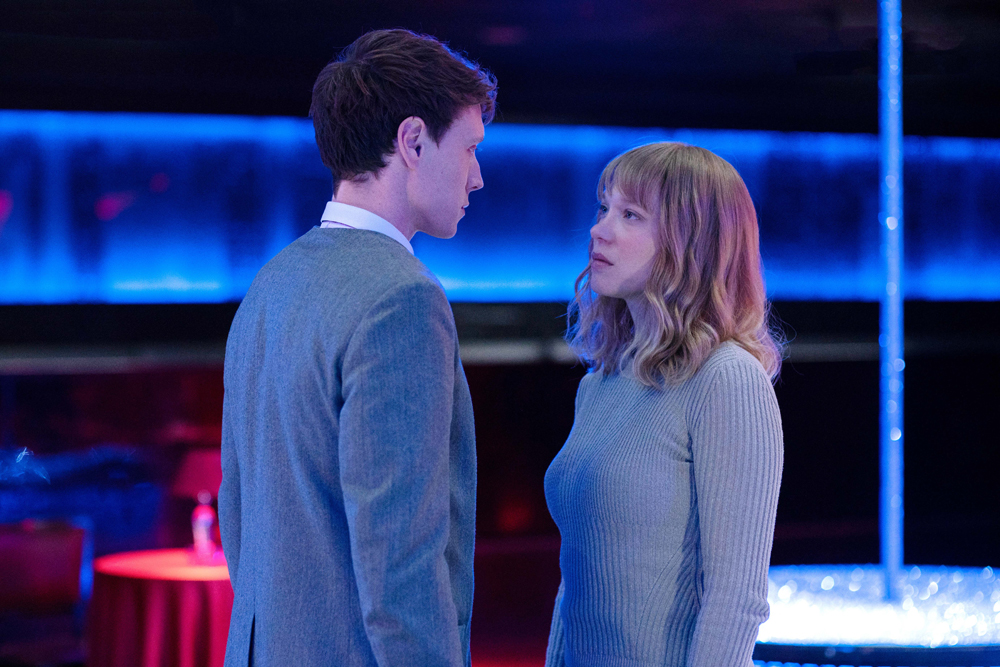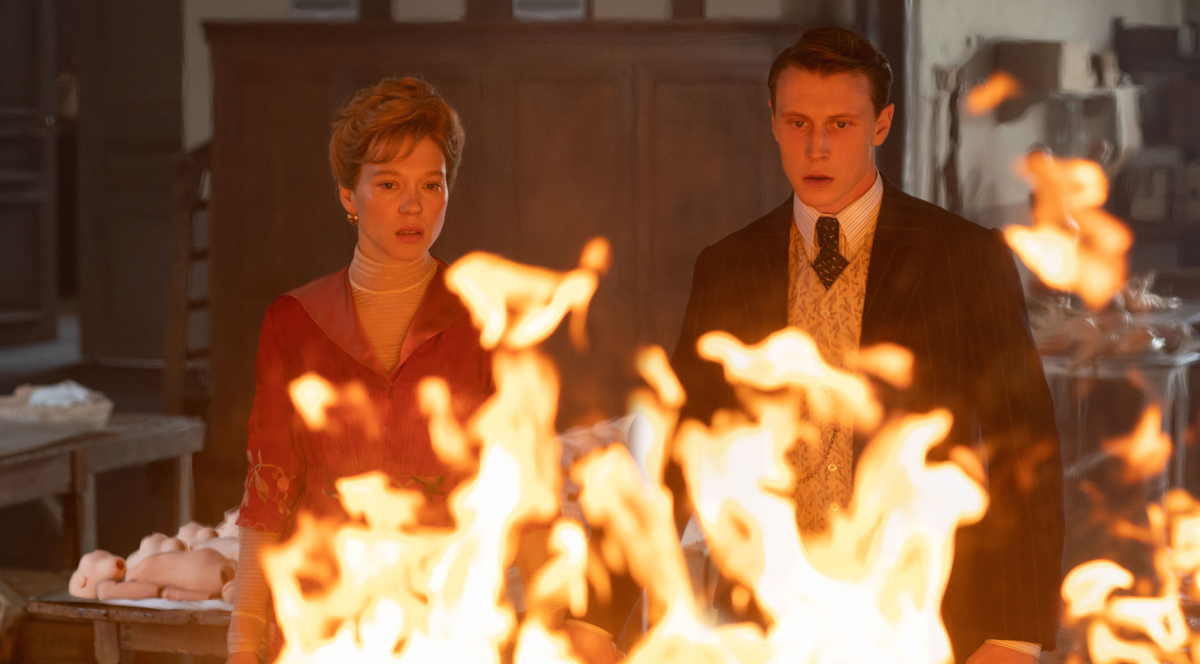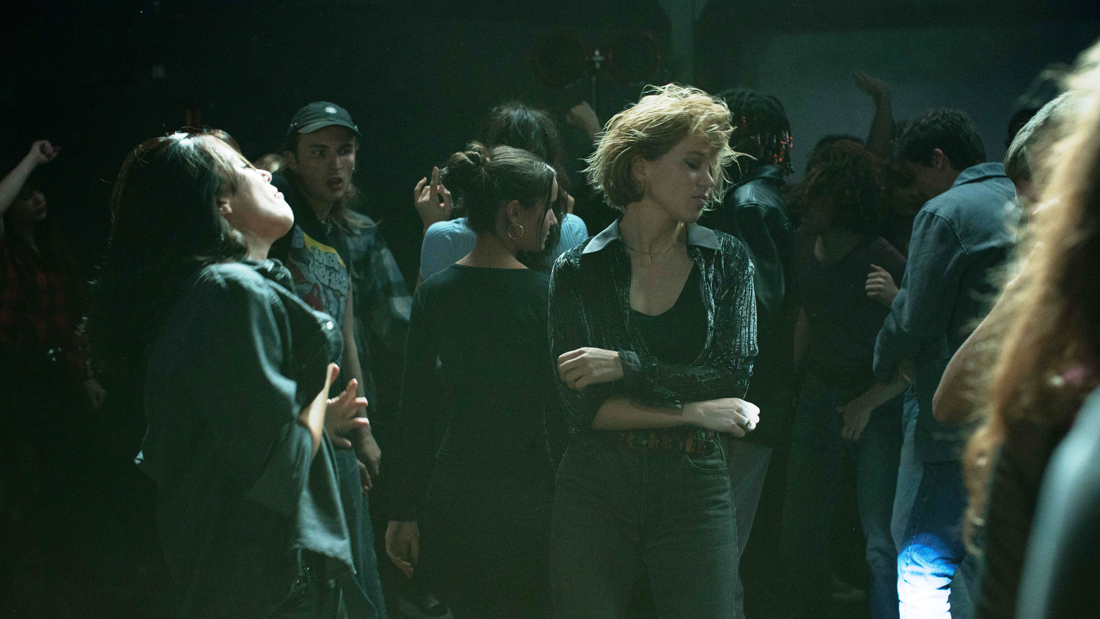 Melissa Anderson
Melissa Anderson
Back to the fear of the future: in Bertrand Bonello’s time-skipping film, the tragedies of love and fate can never be left behind.

George MacKay as Louis Lewanski and Léa Seydoux as Gabrielle Monnier in The Beast. Courtesy Cinetic Media.
The Beast, written and directed by Bertrand Bonello, now playing in theaters in New York and Los Angeles
• • •
An ingenious time-toggling triptych, the latest feature from the French filmmaker Bertrand Bonello takes its title and animating conceit from The Beast in the Jungle, Henry James’s 1903 novella. James’s story concerns John Marcher and his overwhelming sense of foreboding that “something or other lay in wait for him . . . like a crouching Beast in the Jungle,” an unease that he confessed during his initial meeting, in Naples, with a woman named May Bartram, whom he reencounters in London a decade later. “You said you had had from your earliest time, as the deepest thing within you, the sense of being kept for something rare and strange, possibly prodigious and terrible, that was sooner or later to happen to you,” May recalls. Trying to help her obtuse friend pinpoint what, exactly, this mysterious event might be, she offers a suggestion: “Isn’t what you describe perhaps but the expectation—or, at any rate, the sense of danger, familiar to so many people—of falling in love?” Marcher’s tragedy is that he insists on living in abeyance, continuously waiting for this unidentified destiny to reveal itself, only to realize, much too late, that he had failed to recognize it all along: May’s great love for him.

Léa Seydoux as Gabrielle Monnier and George MacKay as Louis Lewanski in The Beast. Courtesy Cinetic Media.
Both the novella’s principal duo and its themes—apprehensiveness about the future, the terror of experience and emotion, and the terror of losing the same—inform the three discrete (but achronological) segments of Bonello’s ambitious film, which take place in 1910, 2014, and 2044. John Marcher and May Bartram are here known as Louis Lewanski (George MacKay) and Gabrielle Monnier (Léa Seydoux); in a gender-flipped departure from James’s text, it is Gabrielle, not Louis, who is beset by a chronic unease about what may happen. In the 1910 chapter, which hews closest to the source, Gabrielle, an acclaimed pianist, remeets Louis at a party in Paris. (Bonello has a fondness for the Belle Époque. His House of Pleasures, from 2011, traces the final months of an upscale Parisian brothel at the dawn of the twentieth century; two cast members from that film make cameo appearances in The Beast’s 1910 section.) For the 2014 version of the dyad, Gabrielle is an aspiring French model-actress house-sitting for the summer in Los Angeles; Louis is an aggrieved thirty-year-old virgin clearly modeled on Elliot Rodger, the incel spree killer, a perverse descendant of Marcher’s volcel. In 2044, Gabrielle, living in a dystopian, AI-ruled, eerily empty Paris, considers a process of “DNA purifying” to rid herself of “old traumas” and deleterious emotions—a procedure necessary to make her free of judgment-impairing “affects” and thus eligible for a more rewarding job than the dull data-recording of her current post (“Today there are no biased decisions made by someone annoyed or depressed,” her AI interlocutor boasts). While exiting the purification center, she meets Louis, who is also contemplating the DNA cleanse.

Léa Seydoux as Gabrielle Monnier in The Beast. Courtesy Cinetic Media.
What 2044 Gabrielle dreads—“never knowing a powerful feeling” again—will likely resonate with the 2024 spectator weary of Big Tech’s relentless pursuit of human “optimization,” with its chilling aims to render obsolete anything that causes discomfort or that cannot easily be reduced to a set of data points, if not to render humans entirely supernumerary. Through its intricate excavation of emotions, The Beast stands as an intimate spectacle, deploying a vast canvas to explore a microscale subject: the roiling inner life of its heroine. Fluidly incorporating three eras, each encompassing its own distinct genre—costume drama, anomic twenty-first-century portrait, speculative fiction—The Beast, like much of Bonello’s best work, accrues hypnotic power by distilling mood and milieu through minimal yet always piquant details and motifs: dolls, discotheques, clairvoyants, pigeons, knives. While the movie may mark the writer-director’s first foray into sci-fi, it is never chilly or clinical; its greatest special effect is the endlessly expressive face, often filmed in extreme close-up, of Seydoux, in her third feature with Bonello.

Léa Seydoux as Gabrielle Monnier in The Beast. Courtesy Cinetic Media.
That visage, no matter the year, is often tearstained, seductive, tremulous. Agreeing to some preliminary DNA disinfecting, Gabrielle, supine in an inky bath with a needlelike probe in her right ear, revisits her past lives from 1910 and 2014. Akin to the physical structure of DNA itself, the three separate time strands operate like helices, at once running parallel to one another and twisting together. That movement, in turn, is mirrored by the action of the bodies on the various dance floors in The Beast. In 2044, for instance, Gabrielle, accompanied by an exceptionally solicitous AI companion called Kelly (Guslagie Malanda, who, in Saint Omer, gave one of last year’s most outstanding performances, as a woman on trial for filicide), goes to a clandestine club that only plays songs from 1972. Marveling at those gyrating to the Pointer Sisters’ “Send Him Back,” Gabrielle seems to have never witnessed people losing themselves so ecstatically in music before—a vestige of life before technology stamped out emotional excess. (Dance sequences are a specialty of Bonello’s, as evidenced in the forest-set mini-rave in 2008’s On War and the thronged nightclubs in his sinuous biopic Saint Laurent from 2014, which features Seydoux as YSL’s muse/model Loulou de la Falaise.)

Léa Seydoux as Gabrielle Monnier and Guslagie Malanda as Poupée Kelly in The Beast. Courtesy Cinetic Media.
In The Beast’s final scene, 2044 Gabrielle learns something so unbearable that her countenance contorts with fathomless pain; so thoroughly does Seydoux transmogrify her visage that she seems to become another person altogether. Just as powerful as that instance of facial ductility, though, is a moment of facial immobility. In 1910, Louis, fascinated to learn that Gabrielle’s husband owns a doll factory, asks whether poupées are created with separate expressions. “There is only one,” she explains. “It’s value-neutral, not too emotional, so that it will please everyone.” She demonstrates that blank, unblinking look for ten seconds. Chillingly, her mien presages The Beast’s grim future, when putative neutrality is upheld as the highest virtue. That future is 2044 Gabrielle’s present. Soon enough, it could be ours. Already it lies in wait for us, ready to pounce.
Melissa Anderson is the film editor of 4Columns and the author of a monograph on David Lynch’s Inland Empire from Fireflies Press.